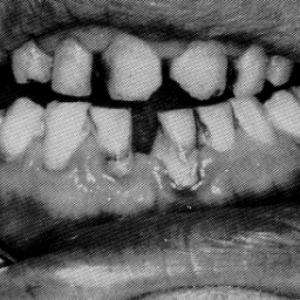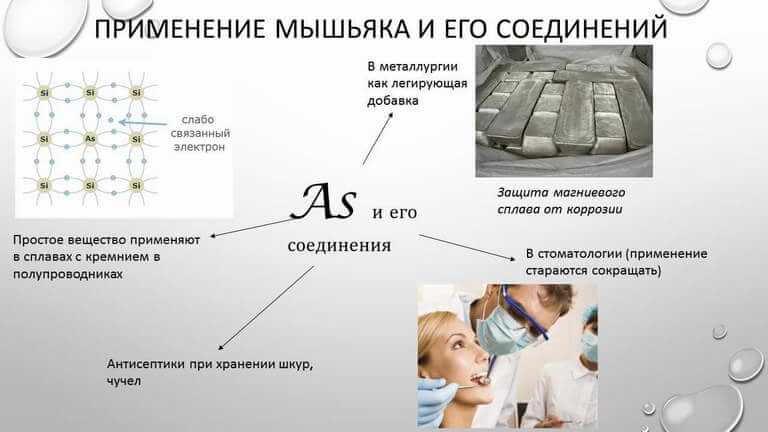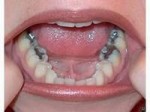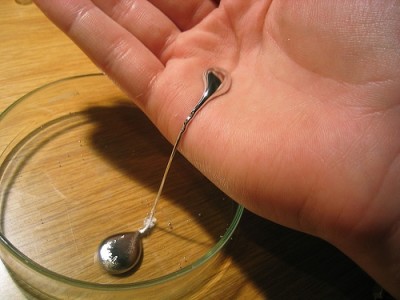Poisoning with salts of heavy metals
Until now, people use utensils containing aluminum for cooking, we drink water saturated with fluoride compounds, and most of the detergents contain chlorine and its derivatives. We are exposed to radiation from household appliances, and we breathe in exhaust-polluted air from millions of cars.
A variety of pesticides are used in agriculture. Dental practice to this day uses amalgam containing mercury for filling teeth.
If the increased content of toxic substances in the air causes the destruction of building facades and corrosion of metals, what happens to the human body? But we receive toxic substances every day not only from the air, but from food and water.
Their gradual accumulation in the body occurs, as a result its defenses (immunity) weaken. Existing chronic diseases are aggravated, dysbiosis develops (a decrease in the number of beneficial microorganisms in the intestine).
As a result - deterioration of health, weakness, decreased performance, illness. Constant contact with all these harmful factors undoubtedly leads to chronic poisoning of the body.
Constant contact with all these harmful factors undoubtedly leads to chronic poisoning of the body.
Salt poisoning takes a significant place among chronic poisoning heavy metals... Heavy metals include more than forty chemical elements with a specific gravity of 6.0 and more.
Of these, the most common are mercury, copper, cadmium, gold, iron, lead, thallium, bismuth, antimony, etc. They are part of industrial organic and inorganic compounds, agricultural herbicides and insecticides, and medicines.
Salts of heavy metals usually enter the body as part of food, with inhaled air, less often through the skin and mucous membranes. Heavy metal salts are able to accumulate in all organs and tissues and remain there for months, causing their progressive damage with subsequent dysfunction.
Symptoms of Heavy Metal Salt Poisoning:
Lesions of the gastrointestinal tract are mainly manifested by complaints such as abdominal pain ,. The long-term effect of the poison leads to the death of the normal intestinal microflora, which causes a violation of bowel emptying, often in the form of constipation, but diarrhea and their alternation are also possible. Disorders of bowel movement are usually accompanied by bloating.
Kidney damage can be characterized by damage to the tubules and glomeruli, with the development and progression of acute or chronic.
The lesions of the nervous system are characterized by a variety of sensory disturbances, movement disorders, and mental symptoms.
However, to a greater extent, the clinical manifestations of chronic poisoning depend both on the type of poison and on its amount and duration of action on the body.
Let us dwell on some specific symptoms of poisoning with the salt of one or another metal.
Mercury predominantly affects the nervous system, which is accompanied by the appearance of the following symptoms: mental agitation, trembling hands or the whole body, sweating, increased salivation, a tendency to increase blood pressure, damage to the mucous membranes of the mouth.
Lead poisoning is manifested by a specific pale earthy color of the skin, a lead lilac-gray border along the edge of the gums and teeth, changes in the blood (increased reticulocytes,), excessive gastric acid secretion, toxic damage to the liver, kidneys, persistent constipation, cramping abdominal pain ...
The defeat of the nervous system is characterized by polyneuritis, signs (weakness, fatigue, sleep disturbance), in severe cases, development. Lead has an adverse effect on the reproductive system, which in women is manifested by a variety of menstrual irregularities, premature birth, and intrauterine fetal death.
Poisoning with arsenic salts often occurs as a result of inhalation of it along with industrial dust. Irritation of the mucous membranes of the eyes, nose, upper respiratory tract occurs, which manifests itself in the form of a runny nose, sometimes hemoptysis. Lesions of the gastrointestinal tract are characterized by nausea, vomiting, impaired liver and intestinal function. When dust gets on the skin, furunculosis, hair loss occurs.
Prolonged contact with antimony leads to disturbances in the digestive tract (decreased appetite, stool disorders, weight loss), inflammatory changes in the oral cavity, itching and cracked skin.
The characteristic symptoms of chronic cadmium poisoning are loss of smell, gastrointestinal disorders, loss of appetite, weight loss, damage to the nasal mucosa, lungs with symptoms of pneumosclerosis.
Treatment principles include:
Termination of further intake of poison into the body (for example, in an industrial environment);
The use of enterosorbents;
Drinking plenty of fluids, and in severe acute cases - (the introduction of large volumes of fluid and powerful diuretics that promote the excretion of toxic substances in the urine by the kidneys);
A diet rich in vitamins, eating a large amount of vegetables and fruits containing fiber and dietary fiber that can bind and remove poison from the body;
The use of antioxidants (vitamins E, A, C and beta-carotene);
Symptomatic therapy aimed at correcting the violation of the internal organs.
The causes of poisoning with salts of heavy metals:
Poisoning with salts of heavy metals occurs when eating foods containing mainly impurities of zinc, lead, copper. They can get into food products during storage or processing by contact with metal utensils, processing equipment or containers.
Enamel or glazed dishes, tin coating of technological equipment and inventory may not contain a large number of lead, the salts of which can pass into food. This is facilitated by the storage of food with high acidity (borscht, marinades, pickled vegetables, dairy products). Milk may contain lead compounds, which are introduced by animals eating grass from pastures near motorways.
Treatment of Poisoning with salts of heavy metals:
using modern enterosorbents.
Enterosorbents ("entero" - internal, "sorbeo" - to attract, absorb), getting into the intestine, "attract" toxic substances to themselves and remove them from the body. In addition, enterosorbents are able to bind and remove microorganisms and their metabolic products.
This process is possible due to the structure of enterosorbents. A large number of pores and active centers are located on their surface, which creates a vast total area of \u200b\u200beffective contact. Due to this, enterosorbents are able to absorb and remove with them from the body a considerable amount of harmful, toxic substances.
The most famous enterosorbent, which is widely used at the present time, is activated carbon.
Unfortunately, the vast majority of enterosorbents capture and remove not only substances hazardous to our health, but also useful ones (vitamins, minerals, trace elements), that is, they have nonspecific sorption. This is not the best way to affect human health.
The most modern and highly effective class of enterosorbents are dietary fiber based on wheat bran fermented by a unique strain of wine yeast.
Where to go:
Medicines, drugs, tablets for the treatment of Poisoning with salts of heavy metals:
Enterosorbents
JSC "Red Star" Ukraine
Calcium preparations.
JSC "Khimfarm" Republic of Kazakhstan
Enterosorbents.
JSC "AVVA RUS" Russia
Calcium metabolism regulator.
JSC "Moskhimfarmpreparaty" them. N. A. Semashko "Russia
Magnesium drug.
FSUE NPO Microgen Russia
Adsorbents.
Adsorbents.
JSC "EKZON" Republic of Belarus
Calcium-phosphorus metabolism regulator.
OJSC "Irbit Chemical and Pharmaceutical Plant" Russia
This is a serious test for the human body, which most often requires the provision of qualified medical care... But doctors say that one of the most dangerous and complex poisonings is associated with salts of heavy metals - the body "absorbs" these compounds in small doses, accumulates them in tissues and organs - this subsequently disrupts the functionality of the whole organism, but quickly remove the toxic substance from the body will not work, because it has already been accumulated!
Doctors warn that heavy metal salt poisoning can be diagnosed in the early stages, but only if a person pays attention to the primary symptoms of the condition in question. It is the early diagnosis of poisoning with salts of heavy metals that makes it possible to make favorable predictions of the condition.
There are over 40 metals that can lead to poisoning. The most dangerous (they also appear most often on the cards of patients) are considered , lead, metallic arsenic, zinc, cadmium... As a rule, poisoning occurs during extensive accidents at specific industries, but in this case we will talk about acute poisoning. As for chronic poisoning with salts of heavy metals, it can happen to a person who has nothing to do with the chemical or metallurgical industry - heavy metals are present in oil refined products, some agricultural products, tobacco smoke and even some food!
Table of contents:Symptoms of heavy metal salt poisoning
There are a number of general symptoms that are characteristic of the clinical picture of poisoning with salts of any heavy metal. These include:
- disorders of the digestive tract :, regular intestinal colic of unexplained etiology, alternating and, often and;
- problems with the nervous system : sensitivity decreases (the victim begins to poorly distinguish aromas, may not feel hot and cold, and so on), problems may develop in the psycho-emotional background (unstable mood, outbreaks of unmotivated aggression and irritability, or, conversely, excessive excitability, and so on).
But there are also symptoms that will be characteristic only of poisoning with a specific metal.
Poisoning with mercury salts
Mercury has the maximum damaging effect on the kidneys, liver and gastrointestinal tract. Therefore, in case of chronic poisoning with mercury salts, the following symptoms will be present:
- pains of varying intensity in the abdomen (intestinal colic of an unstable nature and unexplained etiology);
- problems with stool - both chronic constipation and frequent diarrhea can disturb;
- metal is always present in the mouth;
- ulcerative lesions of the oral mucosa are noted (in medicine, it is called mercury).
Often, with salt poisoning, the central nervous system - the patient may develop persistent tremors (tremors) of the upper limbs and mental overexcitement. In addition, it is for mercury poisoning that periodic unexplained etiology, spontaneous and profuse sweating are characteristic.
Lead poisoning
It is always severe and has a number of distinctive features:

Poisoning with salts of metallic arsenic

This usually happens when you inhale industrial dust; at home, such poisoning does not occur. The symptoms of metal arsenic poisoning will be:
- lesions of the mucous membranes of the respiratory tract and, as a result, constant, chest pain with deep breaths;
- the skin becomes dry, stable and can develop;
- profuse lacrimation is present;
- hemoptysis is often noted;
- hair and nails are damaged - nails become dry, often break, and hair - in large quantities.
Poisoning with antimony and cadmium

Such poisoning will be characterized by:
- dry skin;
- constant;
- the appearance of foci of inflammation in the oral cavity, which are in the nature of ulcers and erosions.
Against the background of these symptoms, the victim has almost no appetite, he is worried about frequent diarrhea - these two factors lead to a sharp weight loss of the patient.

Note: these symptoms can develop rapidly, or they can be of a non-intensive nature - it all depends on the amount of poison entering the body, how powerful the victim is, how the liver and kidneys work, whether the victim has somatic chronic diseases. In any case, with the appearance of similar symptoms, even of weak intensity, it is necessary to seek medical help - lotions, decoctions and tinctures cannot be helped .
Treatment for poisoning with salts of heavy metals
If the clinical picture of poisoning with heavy metal salts is always different depending on the type of poison, then the principles of treatment are general.
First, the doctor must determine exactly what kind of poison is entering / entering the body. It will need to be excluded and selected, in especially severe cases,.
Secondly, the patient is provided with an abundant drink, in addition he is prescribed medications diuretic - this will help remove heavy metal salts through the kidneys. Such a conclusion can be carried out with the help of enterosorbents - the patient will be prescribed activated carbon, Magnesium sulfate, Ksidifon and other drugs of this group.
Thirdly, it will be necessary to conduct a full examination of the patient and establish which organs and how badly they were affected by the salts of heavy metals. Further treatment will depend on this. For example, if the liver is most affected by poisoning, then therapy will be aimed at restoring the function of this particular organ.
In addition, the victim must follow a strict diet. And since in this condition, as a rule, the gastrointestinal tract is primarily affected, there will be a lot of restrictions in the diet. Recommendations for dietary nutrition in case of poisoning with salts of heavy metals:
- Do not get carried away with meat and fish dishes - they should be steamed, or by boiling and it is advisable to grind such food (not in mashed potatoes!).
- and lactic acid products can be consumed in unlimited quantities, but only if diarrhea is not worried.
- Vegetables and fruits should be eaten raw and without restrictions - their fiber is able to "bind" compounds of salts of heavy metals and remove them from the body through the intestines.
- , rosehip decoction, fresh fruit compotes, freshly prepared juices (without preservatives) can be consumed in unlimited quantities - any liquid removes heavy metal salts from the body.
- It is necessary to give up strong tea. Naturally, alcohol is also strictly prohibited.
Concerning traditional medicine, then in case of poisoning with salts of heavy metals, it is powerless. Decoctions and tinctures can be used only as an aid. For example, if the victim has ulcerative lesions in the mouth, then rinsing the mouth with a decoction will bring him relief, and if the patient is suffering from chronic constipation, then oil made from pumpkin seeds will help.
Note: folk remedies (even the best and "tested" neighbors) can not be used for poisoning with salts of heavy metals without first consulting your doctor. Even if chamomile decoction always helped before, it is not a fact that after the condition in question it will not cause a powerful allergic reaction - remember that the immune system in case of any poisoning she is extremely exhausted, weakened.
Rehabilitation period
 In general, treatment for poisoning with salts of heavy metals is quite long and complex. But even after the stabilization of the state of health, the victim needs to undergo a rehabilitation period.
In general, treatment for poisoning with salts of heavy metals is quite long and complex. But even after the stabilization of the state of health, the victim needs to undergo a rehabilitation period.
Heavy metals are chemical elements with the properties of metals or semi-metals. The concept of “heavy metals” is interpreted ambiguously according to different sources, and depending on the criterion for assessing a chemical element (atomic weight, density, toxicity or abundance), the number of elements belonging to the group of heavy metals varies.
Today there is no generally accepted classification of the concept. Meanwhile, the term is used not by chemists, but by doctors and ecologists, since the toxicity of some elements adversely affects environment, and poisoning with heavy metals are ubiquitous and often entail serious complications.
The use of salts of heavy metals in medicine
In medicine, heavy metals are known not only as a pathogenic source of poisoning, but also as effective remedy from some skin diseases. IN ![]() in most cases, drugs used externally are created on the basis of heavy metal salts. Thus, an ointment based on mercury dioxide is used in the treatment of pyoderma and a number of other skin diseases, an ointment made of mercury monochloride is used to treat the cornea and blennorrhea, and colloidal silver is used to treat purulent conjunctivitis. There are a lot of such examples.
in most cases, drugs used externally are created on the basis of heavy metal salts. Thus, an ointment based on mercury dioxide is used in the treatment of pyoderma and a number of other skin diseases, an ointment made of mercury monochloride is used to treat the cornea and blennorrhea, and colloidal silver is used to treat purulent conjunctivitis. There are a lot of such examples.
Heavy metal salts are poorly absorbed through the intestines or mucous membranes, therefore, most often cases of poisoning occur when they come into contact with mercury salts, but this does not mean that contact with other elements will necessarily pass without a trace, so you need to know the symptoms indicating poisoning. Symptoms vary depending on the chemical that caused them.
Mercury enters the body after inhalation of its vapors. About 80% of the substance "settles" in the body. The oxygen in the blood promotes the rapid oxidation and formation of mercury salts. Symptoms of acute poisoning appear several hours after inhalation of mercury vapor. In case of poisoning, the following symptoms are observed:

In the most severe cases of mercury salt poisoning, death can occur several days after the mercury vapor enters the body.
Poisoning with lead salts
Lead makes up about two percent of the earth's crust. The main peak came during the industrial boom, when thousands of workers in manufacturing began to show symptoms of poisoning. Since the end of the 19th century, lead has been added to paint, as a result of which people still continue to get poisoning, which is especially susceptible to children. Poisoning with lead salts entails the appearance of neurological pathologies, often irreversible, so it is very important not to miss their first signs:

In children, the symptoms of poisoning manifest themselves in a slightly different way, in addition, preschoolers are more susceptible to the effects of lead salts and manifestations are noted in them much more often than in others age groups... Particular attention should be paid to signs such as:
- Lethargy, decreased activity. This is the first sign of poisoning, progressing over several weeks;
- Constant vomiting. This is the second round of the development of the disease, when it appears, it is time to sound the alarm;
- Disorientation;
- Impaired coordination. The child often falls, his legs twist, his gait changes noticeably;
- Convulsions. Seizures are the most dangerous sign of lead poisoning in a child. Coma may follow seizures.
Some cases of lead poisoning in a child may be asymptomatic long time, and the damage to the central nervous system resulting from it is irreversible.
Signs of copper salt poisoning
The risk group includes workers involved in the processing and grinding of copper, any solutions of which are extremely toxic to humans. It can enter the body either through the respiratory tract, or orally, along with food. The first signs of acute poisoning with copper salts begin to appear at most - two days after it enters the body. So, the signs that indicate acute poisoning with copper salts:

Prolonged contact with copper solutions without observing elementary safety measures can lead to the development of chronic poisoning with copper salts, in which the functioning of the kidneys, liver and nervous system is disrupted.
Such poisoning occurs extremely rarely. Signs are manifested as a result of ingestion through the respiratory tract or with food, if it is not stored properly. Antimony accumulates in the liver, hair and skin. You can recognize antimony poisoning by the following symptoms:
- Irritation of the upper respiratory tract;
- Irritation of the mucous membrane of the eye with possible damage to the cornea;
- Metal fever symptoms (fever, chills). It is observed when the smoke of antimony oxides enters the respiratory tract;
- Symptoms typical of acute food poisoning. It manifests itself as a result of the ingestion of heavy metal into the body with food.
Chronic poisoning is fraught with fertility disorders in women, lung diseases, skin diseases and anemia.
Signs of poisoning with thallium salts
Thallium is widely used in the manufacture of thermometers, rodent poison and hair removal (in medicine and veterinary medicine). It can enter the body through the respiratory tract, mouth or through the skin through absorption. At first, thallium poisoning is manifested by such signs as:

After some time, usually after a few days, the symptomatology changes and the person has other symptoms:
- Unreasonable worry;
- Dizziness;
- Headaches;
- Sleep disturbance;
- Convulsions;
- Limb tremor;
- Tachycardia;
- Increased blood pressure;
- Changes in the skin. There is a sharp flaking, redness, swelling of the face and legs, hair loss.
In chronic thallium poisoning, sleep disorders, mental disorders, a lichen-like skin rash, kidney and liver damage, paralysis of the eye external muscles, weight loss, and hair loss are noted.
Acute poisoning with salts of heavy metals, regardless of the type of manifestation, requires immediate first aid and subsequent complex treatment.
First aid for poisoning
First aid for heavy metal poisoning is to remove toxic substances from the body. For these purposes, you need to drink as much salted water as possible with the addition of an infusion of emetic root with ipecac.
If the manifestations are very strong, then a cocktail of twenty egg whites mixed in two glasses of milk will come to the rescue. Such a measure, taken immediately after the first manifestations of poisoning, promotes the binding of salts of heavy metals in the stomach, preventing toxins from spreading throughout the body, and then causes severe vomiting. As a result, the body gets rid of toxins.
The next step is to cleanse the intestines, for which you need to do an enema with clean water. The next step is to prevent dehydration. To do this, every three minutes you need to drink soda water, which, if necessary, can be replaced with milk.
Poisoning with heavy metals causes the most serious consequences, especially often poisoning with mercury vapor, as well as those heavy metals that are found in vegetables and fruits after they are pollinated with pesticides. All these pesticides contain heavy metals, and there are more than forty of them. Some of them are mercury, antimony, iron, nickel, manganese, chromium, cobalt, molybdenum, beryllium, lead, copper and others.
When a poison is absorbed into the bloodstream, this affects the work of the internal organs, which are affected by these poisons, and first aid for intoxication with heavy metals consists in stopping their entry into the body and their subsequent excretion. Within a few hours, after the penetration of mercury vapor into the body, a metallic taste appears in the oral cavity, headaches intensify and sore throat appears during swallowing. The more mercury vapor enters the human body, the brighter the symptoms of poisoning will be, while the person begins to have a fever, he has difficulty breathing, and a severe cough develops, and when he inhales deeply, an inflammatory process develops in the lungs, and the chest begins to hurt ... A person who has poisoned with mercury experiences abdominal pain, he begins to diarrhea with mucus and blood, while the body temperature rises, and a large concentration of mercury appears in the urine. When the concentration of mercury vapor was high enough, then everything can be fatal.
If a person has been in contact with mercury for a long time, chronic poisoning begins to develop, and the nervous system is primarily affected. A person becomes apathetic, he has constant headaches, drowsiness, weakness, and sometimes he becomes inadequate. Fingers trembling gradually appears, and then the eyelids and lips begin to tremble, and in the case when the poisoning occurs for a long period and in high concentrations, the whole body begins to tremble. This is due to the fact that mercury is able to concentrate in the brain, as well as in the spleen, liver and kidneys, and excretion occurs with feces and urine, in this case, the half-life of mercury from the human body is at least a month. In the event that first aid has not been carried out for intoxication with heavy metals, then mercury begins to penetrate the membrane of erythrocytes and then binds to hemoglobin and is carried throughout the body. A person who has chronic mercury poisoning loses taste, sense of smell, and the skin becomes insensitive, the person loses touch.
When heavy metals enter the body, they disrupt the biochemical processes in various human organs, and this is especially true for the kidneys and liver, which take all the blows to disinfect blood on themselves. The bad news is that heavy metals that have entered the human body during chronic and acute poisoning can persist in bone tissue for a long time and do not cause any changes that would be expressed in the form of certain diseases. However, in the case when phosphates and calcium begin to be washed out of the bone tissue, heavy metal ions begin to penetrate into the blood, and clinical disorders appear. Clinical symptoms in heavy metal poisoning can also appear several years after the penetration of poisons into the body, for example, during breastfeeding or during pregnancy, when calcium begins to be consumed to build the bones of the infant's skeleton, and in this case, calcium enters with heavy metals in the bones of a child. The clinical picture in the case of heavy metal poisoning is quite diverse and it depends on the human body itself, on the doses and types of poison.
In case of poisoning with heavy metals, the gastrointestinal tract suffers first of all, and almost everyone develops vomiting and diarrhea, and gastrointestinal bleeding is quite often observed. Arsenic poisoning often occurs and the first signs of such poisoning are abdominal pain, diarrhea, vomiting, difficulty swallowing, but the main sign of arsenic poisoning is the smell of garlic when breathing the victim. First aid for intoxication with heavy metals consists in removing all toxic products from the stomach, for this it is necessary to drink a large amount of salted water, with an infusion of emetic root and ipecacuanha. In case of severe poisoning with heavy metals, it is necessary to give the victim a large amount of liquid with protein, and for this you need to take twenty egg whites and mix them in two glasses of milk.
This solution is drunk immediately after poisoning, it causes severe vomiting, binds heavy metals into an insoluble form and frees the stomach from these toxic substances. After washing the stomach, it is necessary to make an enema, preferably from pure water, and then every three minutes give soda or lime water to drink, but you can drink a teaspoon of burnt magnesia diluted in a glass of water. In the event that there is no alkali at hand, then it can be replaced with fresh milk or tannin solution. There are special antidotes for heavy metal poisoning, and one of them is unitiol, it is a universal antidote that is widely used for heavy metal poisoning, it has low toxicity, and perfectly relieves the symptoms of poisoning with lead, copper, mercury, arsenic, antimony and other types of heavy metals ...
Thus, the interaction of a toxic substance and an antidote in the body is of an antagonistic or antidote nature, therefore first aid in case of heavy metal poisoning includes the introduction of antidotes or substances with a similar effect into the body in order to completely exclude damage to the vital important organs, and treat them if necessary.
Heavy metal poisoning is a great threat to the human body. Therefore, it is important to know the symptoms of the disease and provide timely treatment.
In any production, in the medical industry and even in everyday life, heavy metals are an essential attribute. It is necessary to use such a product with caution, regardless of its quantity and scope, since even a slight excess of the concentration of a substance in the human body is fraught with serious health consequences.
Every person who comes across chemicals in the process of his life, he should know where one can face intoxication, what symptoms there are, and whether there is an antidote for a quick recovery.
The reasons
Deal with symptoms and possible treatment this disease is possible only if it is known exactly how the poisoning occurred. In most cases, such intoxication with heavy metal salts occurs due to improper use of the substance, non-observance of safety rules and neglect of protective equipment.
The most common substances that cause heavy metal poisoning are:
- liquid mercury;
- lead particles;
- zinc;
- copper salts;
- nickel;
- antimony.
Intoxication of the human body with salts formed by heavy metals occurs both when the substance is ingested and when hazardous vapors are inhaled, therefore it is important to observe precautions and use all the recommended protective equipment to exclude severe poisoning.
It is important to understand that poisoning can occur both from a single contact with a toxic substance, and from the regular use of metals in production. Chronic poisoning in most cases occurs in employees of large industrial enterprises, for whom contact with toxins is necessary.
Exhaust gases from cars, poisons for rodents and pests, paints, solvents, and even tobacco smoke - all this is a source of penetration of a harmful chemical element into the human body. Ointments and some medications can also pose a serious hazard if misused.
Poisoning
Each metal is separate chemical element, therefore, poisoning by each of them occurs in a peculiar way. The strength with which a particular symptom of the disease manifests itself depends on the duration of contact with the substance, on its characteristic features and the amount that has entered the body.
Note! Poisoning with heavy metal salts is most dangerous for young children. A weak organism is susceptible to a poisonous substance, and therefore the effect is very serious.
Prolonged contact with the substance does not allow the symptoms of intoxication to develop quickly, therefore they appear gradually. Acute poisoning also does not always immediately cause discomfort - sometimes it takes several days for the first signs of the disease to appear.
Mercury
Mercury poisoning is most common, since this metal is used not only in production, but also in everyday life in ordinary thermometers. The symptoms of mercury poisoning appear after two or three hours and can be as follows:
- Perceptible headaches and dizziness.
- Diarrhea interspersed with mucus and blood.
- Swelling of the mucous membranes of the mouth.
- Profuse discharge of saliva and perspiration.
- Tachycardia.
- Respiratory disorders.
- Fainting.
Lead
Symptoms that appear in case of poisoning with salts of heavy metals are different for each substance. are characterized by the following signs:
- significant memory problems;
- general lethargy and a state of apathy;
- convulsive conditions of some muscle groups;
- problems with coordination of movements;
- discomfort in joints and bones;
- feeling of nausea, vomiting;
- decreased appetite, development of symptoms of anorexia;
- problems with bowel movements;
- tremor of the limbs.
Copper
Intoxication with copper salts also brings a lot of discomfort to the victim. Among the main symptoms, the following may occur:
- Increase in general body temperature up to 39 degrees.
- Unpleasant headaches and dizziness.
- Nausea and regular vomiting.
- Unpleasant sensations in the intestines.
Antimony
The metal used in ancient times to blacken eyebrows can also be harmful to human health. Metal powder or salt resulting from chemical reactionscan cause the following symptoms:
- discomfort in the throat, persistent cough;
- acute conjunctivitis;
- an increase in the general body temperature up to forty degrees;
- joint pain;
- constant nausea, vomiting;
- frequent diarrhea.
Thallium
Thallium is one of the most dangerous metals for the human body. It can enter the body and cause damage even without ingestion - enough vapors that penetrate through the pores in the skin. Symptoms appear during the first days after intoxication and may be as follows:
- Feeling of nausea and frequent vomiting.
- Diarrhea.
- Increased flatulence.
- Unpleasant sensations in the abdomen.
- Unreasonable anxiety.
- Convulsive conditions resembling an epileptic seizure.
- Problems with the perception of the surrounding reality.
- Redness of the skin of the face.
The danger
Intoxication with any of the heavy metals threatens the body with serious consequences. It is this kind of poisoning that can disrupt the functions of many important organs, due to which the development and existence of a person becomes impossible. The antidote for treatment must be administered immediately after the onset of the primary symptoms, otherwise the disease will cause irreparable harm.
The most common pathologies that threaten a poisoned person should be known to every person who periodically encounters harmful substances:
- The functional work of the brain is impaired, due to which memory problems appear, speech is impaired. Severe seizures may appear, emotional instability provokes mental disorders. If poisoned small childprobably mental retardation.
- Toxins infect the liver, resulting in toxic hepatitis. The organ can no longer process harmful substances, the disease causes a lot of trouble and does not allow living full life... The liver increases significantly in size, its functions are almost completely impaired, and noticeable pain appears in the ribs.
- Acute hepatic and renal failure also becomes an unpleasant consequence of the disease. The kidneys no longer purify the blood, which allows all toxins to spread easily throughout the body. In this case, the amount of urine can either increase significantly or decrease markedly in comparison with the norm for a healthy person.
- Anemia develops, which results in the breakdown of red blood cells.
It is important to prevent the development of intoxication and provide timely treatment, otherwise the victim will not be able to return the victim's health. Toxic substances affect not only the listed systems - the spread of poisons continues even after the start of treatment, if the organs are not able to process and remove substances from the body.
Video: the effect of metals on human health.
Help
Providing first aid to the victim in a timely manner means significantly increasing his chances of getting rid of unpleasant consequences. It is important to treat the rescue of the patient with full responsibility, and the first action will be the mandatory call of a team of specialists who will assess the degree of poisoning, carry out the necessary diagnostics, and then prescribe treatment.
Treatment of the disease is carried out only in the hospital, but before the arrival of doctors, you can independently alleviate the patient's condition:
- If poisoning has occurred by inhalation of harmful metal vapors, it is necessary to remove the victim to fresh air as soon as possible and prevent the toxin from re-entering the body. If this action is not possible, you need to open all windows and doors in the room for proper ventilation and provide access to fresh air.
- When the toxin is ingested, the victim must be vomited as soon as possible. The best way to do this would be a large number of warm waterdrunk in one gulp. The stomach is flushed until all contents are completely expelled and until clean water is obtained at the outlet.
- If metal salts get on the skin and mucous membranes, rinse them with warm running water. Washing should be done for at least twenty minutes, this will ensure complete removal of the substance and reduce the intake of toxin into the body.
Note! In no case should you refuse medical care and engage in self-treatment, even if the victim has become noticeably better. Any wrong actions can lead to serious consequences that will only aggravate the patient's condition.
After arrival medical professionals all assistance is provided only with the help of special drugs and procedures. The victim is introduced medicines, ensuring the stable functioning of the heart and respiratory organs, the intoxication of the body is reduced as quickly as possible with the help of an antidote or other means.
If necessary, the victim is sent to the hospital, where full treatment is carried out, drug therapy and a special diet are prescribed to minimize the risk of consequences. It is not recommended to refuse medical care - dangerous consequences strike the body, and all important functions can be restored only with the help of a professional.
Employees of large industrial enterprises should remember that a responsible attitude to safety measures, adherence to technology and the use of protective equipment can reduce the risk of infection tenfold, therefore it is important to pay attention to the actions of each employee.
Only careful attention to the use of heavy metals, adherence to all the rules for operating equipment, careful handling of elements containing metal in everyday life will ensure a full life without the risks of death and unpleasant consequences that endanger human safety.






